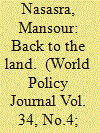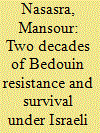|
|
|
Sort Order |
|
|
|
Items / Page
|
|
|
|
|
|
|
| Srl | Item |
| 1 |
ID:
157404


|
|
|
|
|
| Summary/Abstract |
The Indigenous Arab Bedouin have lived in southern Palestine for centuries, mainly in the city of Beersheba, known as Bir al-Saba’ in Arabic. The community preserved its traditional Islamic culture under Ottoman and British rule, and has continued to do so under the sedentarization polices of the Israeli state. Various regimes have come and gone in the Naqab, a region that today accounts for more than half of Israel’s landmass, but the Bedouin have remained loyal to their ancestral lands.
|
|
|
|
|
|
|
|
|
|
|
|
|
|
|
|
| 2 |
ID:
179082


|
|
|
|
|
| Summary/Abstract |
Naqab Bedouin resistance and political activism against the Israeli Prawer plans attracted attention in many local and international contexts and became a symbol of sumud [steadfastness] among Palestinians in Israel. In fact, the Bedouin, led at this time by motivated youth and women activists, showed greater creative, tactical and strategic agency and skills than politicians and scholars acknowledged in the past, and they actively contributed to shaping aspects of their own destiny within the state structure. We argue that creative, nonviolent, everyday and political resistance and activism, led by the young Bedouin [al-hirak al-shababi], succeeded in modifying and mitigating the Israeli Prawer Plan policies and strategies to relocate and expel the Bedouin from their historical villages. This study draws on a number of in-depth interviews in the Naqab with male and female youth, activists, and politicians. Specifically, it shows how Bedouin women and youth were key actors in resisting the Prawer Plan using social media tactics, which later led to Israeli withdrawal and freezing of the plan in 2013. The evolution of Bedouin resistance and the prevailing misrepresentation of the Bedouin is identified and tested through the case study of the anti-Prawer campaign and the Naqab Bedouin villagers’ on-going resistance to being forcibly relocated from their historical land in the Naqab.
|
|
|
|
|
|
|
|
|
|
|
|
|
|
|
|
| 3 |
ID:
174143


|
|
|
|
|
| Summary/Abstract |
Using archival data and newspaper collections from Britain and Israel, and extensive fieldwork interviews in the Naqab, this article breaks new ground through a critical examination of the Bedouin and their way of surviving and resisting Israeli military rule, 1948–1967. I argue that creative nonviolent resistance, everyday resistance and sumud (steadfastness and resilience), succeeded in modifying and mitigating the military rule strategies deployed by the state to control the Arab Bedouin, opening up the possibility of further political action and communal protection. By employing sumud as everyday resistance, the Bedouin improved their livelihood, strengthened one another and helped consolidate sumud, to the point where sumud became part of their culture and way of life during the military rule. Everyday sumud strategies were through border economy and contact with their relatives across the border, which utilized the strong relationships between tribes. Smuggling goods was a central form of economic survival and sumud. Everyday resistance and nonviolent actions succeeded in marginalizing military rules, restrictions, and power, allowing the Bedouin to gain immediate benefits including many of their daily needs. The Bedouin maintained their cross-border relations and continued to resist cooperation with the Israeli military rule. Hosting their fellow refugees was a daily act of sumud by the Bedouin despite the imposition of new state borders. The Bedouin also found different avenues to claim their dispossessed properties, and continued to resist Israeli confiscation of their land. They lodged land claims through every level of military rule, responding to different Israeli forms of power and the effect of domination.
|
|
|
|
|
|
|
|
|
|
|
|
|
|
|
|
|
|
|
|
|